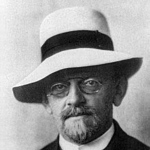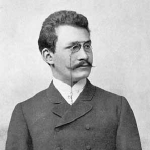Background
Karl Schwarzschild was born on October 9, 1873, in Frankfurt Am Main, Bayern, Germany. His father was active in the business community of the city, and the family had ancestors in the city dating back to the sixteenth century.

Martin Schwarzschild
Ludwig Maximilian University of Munich
Karl Schwarzschild's grave at Stadtfriedhof (Göttingen)




Karl Schwarzschild was born on October 9, 1873, in Frankfurt Am Main, Bayern, Germany. His father was active in the business community of the city, and the family had ancestors in the city dating back to the sixteenth century.
Karl Schwarzschild attended a Jewish primary school until 11 years of age. He was something of a child prodigy, having two papers on binary orbits (celestial mechanics) published before he was sixteen. He studied at Strasbourg and Munich, obtaining his doctorate in 1896 for work on Henri Poincaré's theories.
From 1897, Karl Schwarzschild worked as an assistant at the Kuffner Observatory in Vienna. From 1901 until 1909 he was a professor at the prestigious institute at Göttingen, where he had the opportunity to work with some significant figures, including David Hilbert and Hermann Minkowski.
Karl Schwarzschild became the director of the observatory in Göttingen. Later he moved to Potsdam, where he took up the post of director of the Astrophysical Observatory. This was then the most prestigious post available for an astronomer in Germany.
At the outbreak of World War I in 1914 Karl Schwarzschild joined the German army, despite being over 40 years old. He served on both the western and eastern fronts, rising to the rank of lieutenant in the artillery. While serving on the front in Russia in 1915, he began to suffer from a rare and painful autoimmune skin disease called pemphigus. Nevertheless, he managed to write three outstanding papers, two on the theory of relativity and one on quantum theory. His papers on relativity produced the first exact solutions to the Einstein field equations, and a minor modification of these results gives the well-known solution that now bears his name - the Schwarzschild metric.
Schwarzschild's struggle with pemphigus may have eventually led to his death on 11 May 1916.
Karl Schwarzschild provided the first exact solution to the Einstein field equations of general relativity, for the limited case of a single spherical non-rotating mass, which he accomplished in 1915, the same year that Einstein first introduced general relativity. The Karl Schwarzschild solution, which makes use of Schwarzschild coordinates and the Schwarzschild metric, leads to a derivation of the Schwarzschild radius, which is the size of the event horizon of a non-rotating black hole.
Karl Schwarzschild married Else Rosenbach, the daughter of a professor of surgery at Göttingen, in 1909. He and Else had three children, Agathe (who was a Classics professor at the University of Otago in Dunedin, New Zealand), Martin (who went on to become a professor of astronomy at Princeton University), and Alfred.

From 1901 until 1909 Karl Schwarzschild was a professor at the prestigious institute at Göttingen, where he had the opportunity to work with some significant figures including David Hilbert and Hermann Minkowski.

